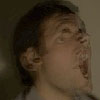Jodi_11_19_03
Jodi_11_20_03_01
Jodi_11_20_03_02
Jodi_11_20_03_03
Jodi_11_20_03_04
Jodi_11_20_03_05
Jodi_11_20_03_06
Jodi_11_20_03_07
Jodi_11_20_03_08
---------------------------
[Please note: the date on the e-mail messages are the 20 and 21 of November; this is because Jodi.org live in Europe and their time is ahead of U.S time.]
::Eduardo Navas::
"The program works by providing an interface through which the user can allocate descriptive keywords to specific parts of the movie's timeline. Once the user is satisfied that the movie file has been adequately annotated with descriptive and evocative words, these words are automatically entered into Lycos's multimedia search engine and corresponding sound files are retrieved from the World Wide Web.
When the movie is played back, each retrieved sound starts to play when the point in the timeline associated with its keyword is reached."
Designed to compose audio tracks not fully controlled by the user, the composed sound has the potential to be based on context rather than content and to produce unexpected collages of sounds. The process of editing and layering the sounds over the already edited video becomes a formalized, selective, and regenerative process (using found sounds) wherein the application takes control. At no point is the user allowed to participate in the process of selecting and pre-editing their sounds; these are chosen by the application only in the final stages, allowing the user to position them. The final result is a technique as structured, formal, and unexpected as the cut-up techniques of Brion Gysin and William Burroughs.
Not without its little quirks, Soundtracker does require a little patience, but it's well worth the time invested to make it work.
:: Garrett Lynch ::
 Two
French
pieces
of
net
art
entitled
"Le
Cri"
("The
Scream"),
flyingpuppet.com
and
the
second
by
Michael
Sellam
of
incident.net.
Two
French
pieces
of
net
art
entitled
"Le
Cri"
("The
Scream"),
flyingpuppet.com
and
the
second
by
Michael
Sellam
of
incident.net.The title, The Scream, comes from Edvard Munch's 1893 painting illustrating the fear, angst, depression, and helplessness brought on by modern living that the artist felt more acutely than anyone else. Munch himself stated of the day he conceived the painting:
"I was walking along the road with two friends.
The sun was setting.
I felt a breath of melancholy -
Suddenly the sky turned blood-red.
I stopped, and leaned against the railing, deathly tired -
looking out across the flaming clouds that hung like blood and a sword
over the blue-black fjord and town.
My friends walked on - I stood there, trembling with fear.
And I sensed a great, infinite scream pass through nature."
Presented here in digital media form (moving, sound, interactive), we see that while the form might advance and grow ever more sophisticated, the themes of artists remain the same.
:: Garrett Lynch ::